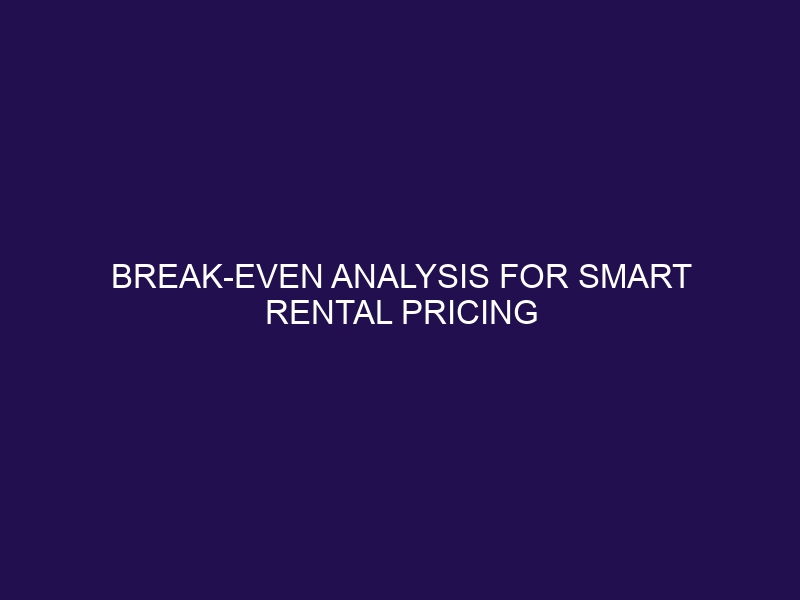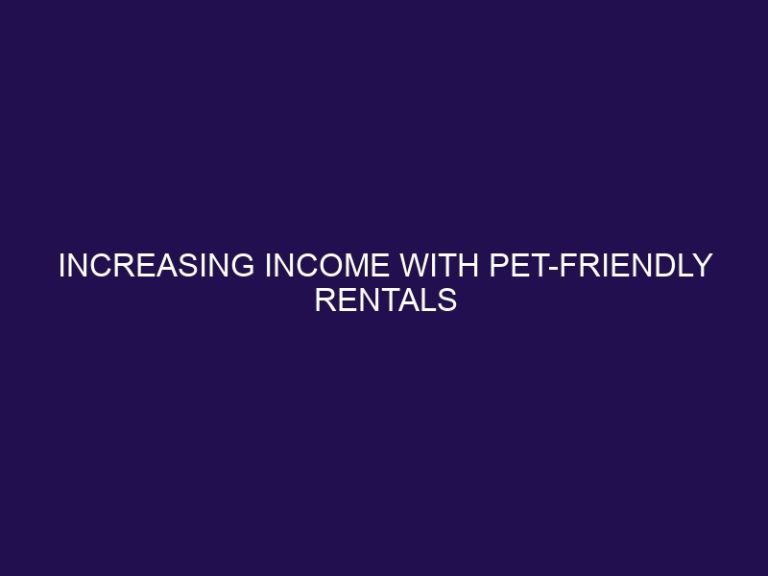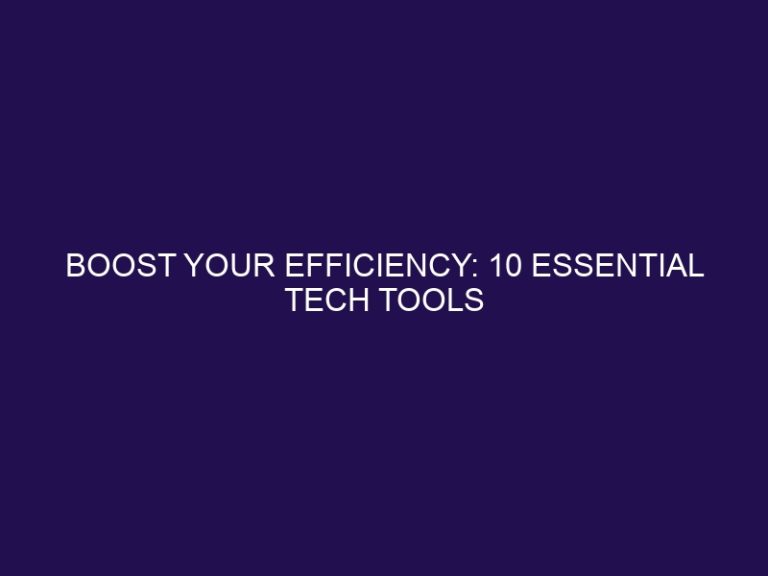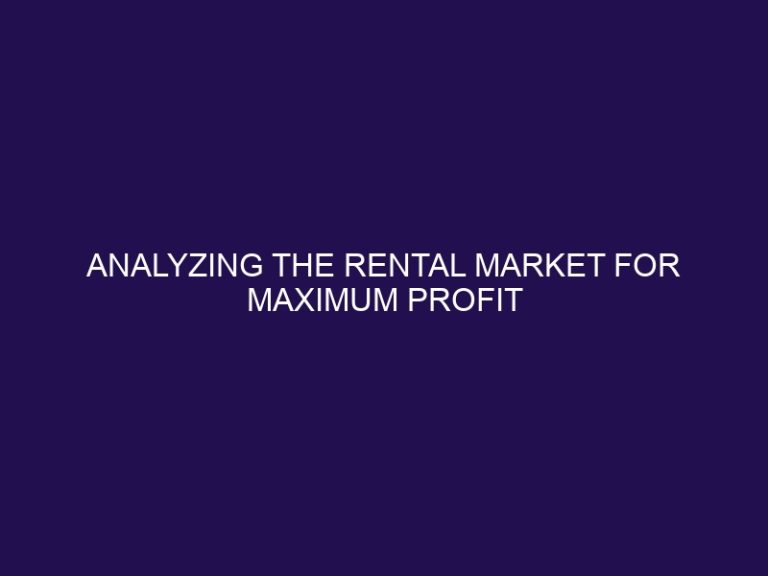Break-Even Analysis for Smart Rental Pricing
Break-even analysis is a powerful tool used by businesses to evaluate the financial feasibility of a product or service. It helps determine the minimum amount of sales needed to cover all costs and break-even. In the context of smart rental pricing, break-even analysis is crucial to ensure the profitability of rental properties.
Break-even analysis consists of two components: fixed costs and variable costs. Fixed costs are expenses that remain constant, regardless of the level of sales. On the other hand, variable costs are directly related to the amount of sales and vary accordingly.
For smart rental pricing, break-even analysis is essential as it allows property owners to determine the minimum rental rates needed to cover all costs and generate a profit. It also helps identify potential cost-cutting opportunities and evaluate the profitability of rental properties.
To perform break-even analysis for smart rental pricing, follow these four steps:
- Determine Fixed Costs: These include expenses such as property taxes, insurance, and mortgage payments.
- Calculate Variable Costs: These include expenses such as maintenance, repairs, and utilities.
- Determine the Break-Even Point: This is the minimum occupancy rate required to cover all costs and break-even.
- Analyze the Break-Even Point: Compare the break-even point to the expected occupancy rate and adjust rental rates accordingly.
Several factors influence the break-even point for smart rental pricing, including occupancy rate, rental rates, operating expenses, and seasonal fluctuations. Property owners must carefully consider these factors to ensure their rental rates are competitive and profitable.
Break-even analysis can help with smart rental pricing decisions in various ways, including:
- Setting Competitive Rental Rates: By determining the minimum rental rates needed to break-even, property owners can ensure their rates are competitive and attractive to potential tenants.
- Identifying Cost-Saving Opportunities: Break-even analysis can identify areas where costs can be reduced, such as maintenance and operating expenses, to increase profitability.
- Evaluating the Profitability of Rental Properties: By comparing the break-even point to the expected occupancy rate, property owners can evaluate the profitability of their rental properties and make informed decisions.
However, break-even analysis has limitations, such as assuming constant costs and revenue, not considering external factors, and being limited to short-term analysis. Property owners must consider these limitations when using break-even analysis for smart rental pricing decisions.
What Is Break-Even Analysis?
Break-even analysis is a tool used to determine the point where total revenue equals total costs, indicating the minimum sales needed to cover all expenses. This analysis helps businesses assess profitability and set pricing strategies. By understanding what break-even analysis is, businesses can make informed decisions regarding their cost structure and sales targets.
What Are the Components of Break-Even Analysis?
The components of break-even analysis include:
- Fixed costs, which are expenses that remain constant regardless of production levels.
- Variable costs, which change depending on output.
- The break-even point, which is the point at which total revenue equals total costs, indicating neither profit nor loss.
Why Is Break-Even Analysis Important for Smart Rental Pricing?
The importance of break-even analysis for smart rental pricing lies in its ability to determine the minimum rental rate necessary to cover costs. This analysis is essential for setting competitive and profitable prices, as well as understanding how various cost and pricing scenarios can impact the profitability of a rental business.
How to Perform Break-Even Analysis for Smart Rental Pricing?
In order to set a profitable rental price for your property, it is crucial to perform a break-even analysis. This section will guide you through the steps of conducting a break-even analysis for smart rental pricing. First, we will discuss how to determine the fixed costs associated with your rental property. Then, we will explore how to calculate the variable costs. Next, we will cover how to determine the break-even point, which is the point where your revenue equals your costs. Finally, we will analyze the break-even point and how it can inform your rental pricing decisions.
Step 1: Determine Fixed Costs
To calculate fixed costs for smart rental pricing:
- Identify recurring expenses such as property taxes and insurance.
- Include non-cash expenses like depreciation.
- Factor in long-term commitments such as mortgage payments.
Did you know? Fixed costs play a crucial role in determining the break-even point and ultimately impacting rental profitability.
Step 2: Calculate Variable Costs
- Identify all variable costs directly tied to each rental unit.
- Compute the total of these variable costs for accurate break-even analysis.
- Include expenses such as maintenance, utilities, and property management fees in the calculation.
Step 3: Determine the Break-Even Point
- Calculate the total fixed costs for a rental property.
- Determine the contribution margin per unit.
- Divide the total fixed costs by the contribution margin to find the break-even point in units.
A property owner utilized Step 3 to determine the break-even point for their vacation rental, ensuring optimal pricing for profitability.
Step 4: Analyze the Break-Even Point
- Compare the break-even point with actual sales to determine profitability.
- Analyze deviations between projected and actual break-even points to identify potential areas for improvement.
- Examine factors that may have influenced variances, such as unexpected expenses.
Did you know? Regularly analyzing the break-even point can help refine rental pricing strategies.
What Factors Influence the Break-Even Point for Smart Rental Pricing?
When determining the optimal rental price for a property, it is important to consider the break-even point – the point at which the income from renting out the property covers all expenses. However, the break-even point can vary depending on various factors. In this section, we will discuss the key factors that influence the break-even point for smart rental pricing. These include the property’s occupancy rate, rental rates, operating expenses, and seasonal fluctuations. By understanding these factors, property owners can make informed decisions to maximize their profits and minimize risk.
1. Occupancy Rate
- Examine historical occupancy rates to identify trends and patterns.
- Predict future occupancy based on market demand and seasonal variations.
- Adapt pricing and marketing strategies to maximize occupancy and revenue.
Did you know? Occupancy rate is a crucial measure for evaluating rental property performance.
2. Rental Rates
Rental rates are a vital factor in break-even analysis for intelligent rental pricing. Establishing the correct rental rates guarantees that the property generates enough income to cover both fixed and variable costs, ultimately reaching the break-even point.
Fact: In a competitive rental market, setting the optimal rental rate is crucial for attracting tenants and maximizing property revenue.
3. Operating Expenses
Operating expenses for smart rental pricing include maintenance, property management fees, and utilities. It is crucial to accurately track these costs for an effective break-even analysis. Pro-tip: Regularly review and adjust operating expenses to ensure accurate calculations for break-even and to maximize profitability.
4. Seasonal Fluctuations
Smart rental pricing is greatly influenced by seasonal fluctuations, such as increased demand during summer and lower occupancy in winter. In tourist destinations, rental rates tend to soar during peak seasons, while they drop during off-peak periods. Historical data shows that coastal properties experience a 20% price hike during the summer months.
How Can Break-Even Analysis Help with Smart Rental Pricing Decisions?
Making rental pricing decisions can be a daunting task for property owners and managers. However, utilizing a break-even analysis can provide valuable insights and guidance for setting competitive rental rates, identifying cost-saving opportunities, and evaluating the profitability of rental properties. In this section, we will discuss how break-even analysis can be a powerful tool for making smart rental pricing decisions.
1. Setting Competitive Rental Rates
- Research local rental market rates.
- Consider property amenities and location.
- Analyze demand and occupancy rates in the area.
- Factor in property maintenance and management costs.
When I was setting competitive rental rates for my vacation property, I thoroughly researched similar listings, took into account the property’s unique features, and made adjustments based on seasonal demand. This strategic approach led to increased bookings and positive guest reviews.
2. Identifying Cost-Saving Opportunities
- Assessing energy-efficient upgrades and maintenance to decrease utility expenses.
- Consolidating supplier contracts for volume discounts.
- Implementing technology for streamlined operations and decreased labor costs.
3. Evaluating the Profitability of Rental Properties
- Analyze rental income against fixed and variable costs to evaluate the profitability of rental properties.
- Consider the long-term profit potential by factoring in property appreciation when evaluating the profitability of rental properties.
- Assess the impact of market trends and demand on the profitability of rental properties.
What Are the Limitations of Break-Even Analysis for Smart Rental Pricing?
While break-even analysis can be a useful tool in determining rental prices for a smart rental property, it is not without its limitations. In this section, we will discuss the potential drawbacks of using break-even analysis for smart rental pricing. These include the assumptions of constant cost and revenue, the lack of consideration for external factors, and the limited scope of short-term analysis. By understanding these limitations, we can better utilize break-even analysis in conjunction with other methods for optimal rental pricing.
1. Assumes Constant Cost and Revenue
- Constant Costs: Break-even analysis assumes that fixed costs remain unchanged.
- Steady Revenue: It presupposes that revenue will stay consistent over the analyzed period.
Pro-tip: It is important to regularly update your break-even analysis to reflect any changes in market conditions.
2. Does Not Consider External Factors
- Consider broader economic conditions like market trends and government regulations.
- Evaluate social factors, such as changing demographics and cultural shifts.
- Assess environmental impacts on property, like sustainability requirements and climate change effects.
When considering external factors, it’s essential to analyze the long-term implications on rental pricing to make informed decisions.
3. Limited to Short-Term Analysis
- Conduct regular long-term analysis alongside break-even for holistic insights.
- Integrate industry trends and market forecasts into decision-making.
- Implement flexible strategies to adapt to evolving economic conditions, while also being limited to short-term analysis.
A property management company utilized long-term analysis to anticipate market shifts, leading to strategic adjustments that sustained profitability during a downturn.
Frequently Asked Questions
What is break-even analysis and why is it important for small business owners?
Break-even analysis is a financial calculation that helps determine the minimum product level at which a business neither makes a profit nor incurs a loss. It is important for small business owners to conduct this analysis in order to make informed decisions about pricing, financial planning, and long-term profitability.
What are the key components of a break-even analysis?
The key components of a break-even analysis include fixed costs, which are expenses that do not change with sales, variable costs, which fluctuate with production and sales volume, and break-even point, which is the minimum product level needed to cover production costs.
How can performing a break-even analysis benefit a business?
Performing a break-even analysis can help a business set sales revenue targets, make important financial decisions, and ensure long-term profitability. It also allows for a better understanding of the business’s financial health and can help determine the viability of a new product or service.
What are some common mistakes made by small business owners in terms of break-even analysis?
Many small business owners do not perform a meaningful financial analysis, do not consider all necessary costs, and do not set realistic sales revenue targets. It is important for business owners to take the time to catch missing expenses and conduct a thorough break-even point analysis in order to make informed decisions.
Can break-even analysis be applied to any type of business or product?
Yes, break-even analysis can be applied to any type of business or product. Whether it’s a bake sale or a web development company, the basic principles of break-even theory can be used to determine the minimum product level needed to cover production costs and start turning a profit.
What is Lightspeed’s perspective on break-even analysis and its role in financial planning for small and medium-sized businesses?
Lightspeed’s CFO, Rob Stephens, believes that break-even analysis is a critical part of the small business accounting process. It allows business owners to make important financial decisions and set realistic sales targets in order to achieve long-term profitability and store growth. Lightspeed’s year in review also highlights the importance of break-even analysis in their own business operations.







